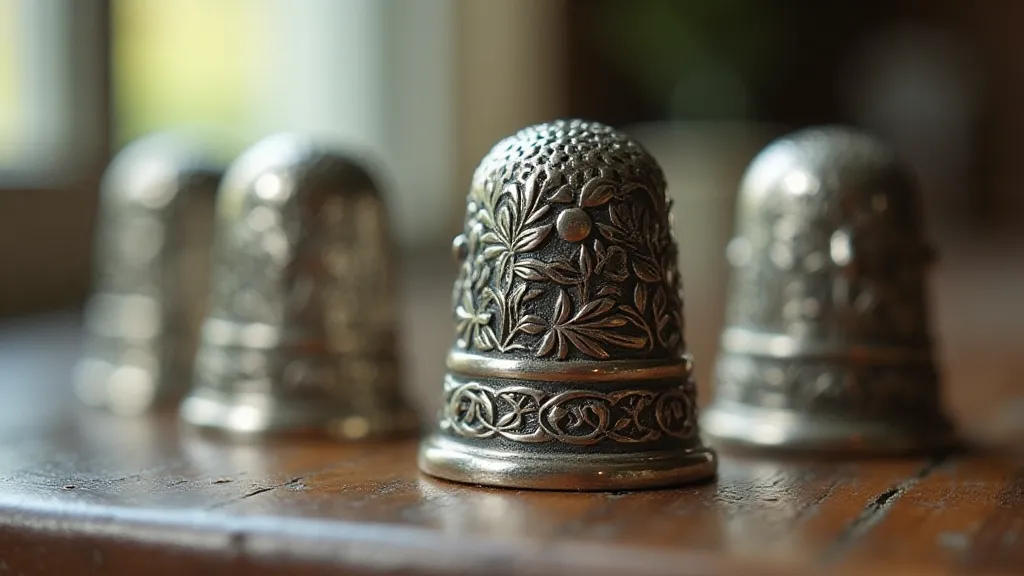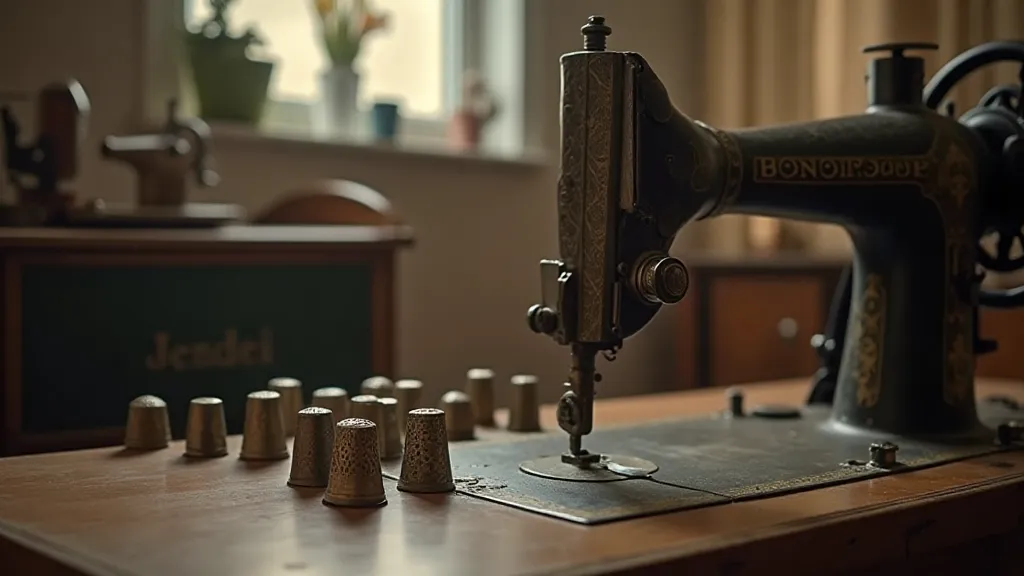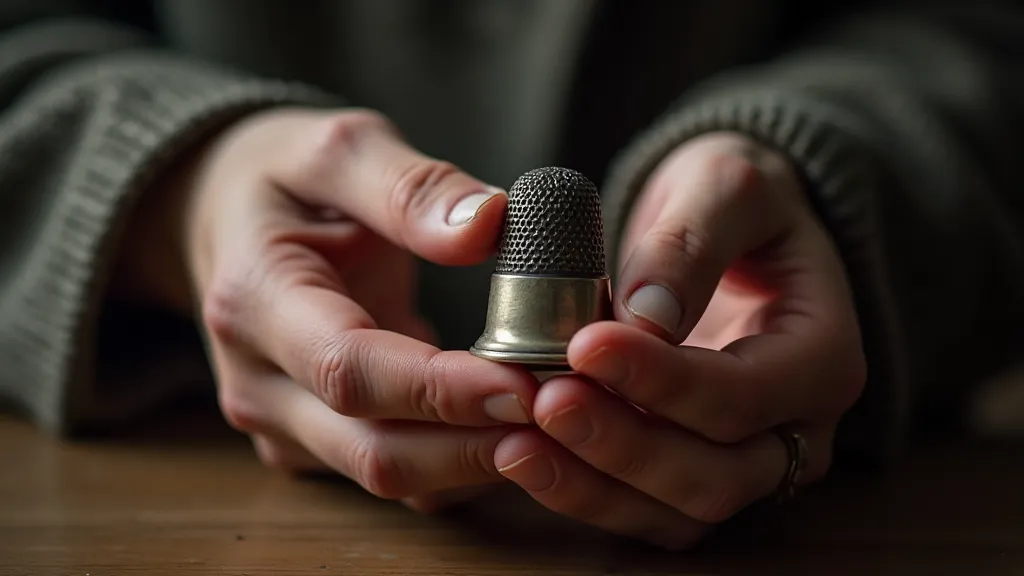The Collector's Shadow: Obsession, Memory, and the Pursuit of Miniature Perfection
There’s a quiet beauty to a thimble. More than just a tool, a tiny shield for a finger navigating the dance of needle and thread, they are miniature repositories of history, craft, and memory. They sit in our hands, cool and smooth, often overlooked, yet capable of sparking a profound connection to the past. For the dedicated collector, this connection transcends mere appreciation; it becomes a quest, a passion, a delicate dance between obsession and sentiment. The pursuit of antique thimbles isn't just about acquiring objects; it's about inheriting echoes of lives lived, stories stitched, and artistry preserved within these diminutive artifacts.
I remember my grandmother’s thimble box. It wasn’t grand – just a simple, worn wooden box, stained with years of spilled sewing supplies and the residue of countless projects. Inside, nestled amongst spools of thread and tangled scraps of fabric, lay a collection of thimbles – a silent, silvered chorus of bygone eras. I, a curious child, would sift through them, captivated by their variety. Some were plain, utilitarian brass; others, intricately decorated with floral patterns or delicate scenes. Each one seemed to whisper a forgotten tale. That initial fascination, that childish wonder, planted a seed – a seed that blossomed into a lifelong appreciation for these often-unnoticed treasures.

A Stitch in Time: Historical Context
The history of thimbles is surprisingly rich. While rudimentary finger protectors existed long before, the thimble as we know it began to emerge in Europe during the 16th century. Initially crafted from materials readily available – wood, leather, and horn – they quickly evolved with the burgeoning skills of metalworkers. The rise of the sewing machine in the 19th century increased the demand, leading to mass production. However, the true gems reside in the earlier, hand-crafted pieces. Early thimbles offer a unique window into the artistry of the era, and reflect a time when even small objects were imbued with significant cultural importance. Examining their evolution is like tracing the journey of craftsmanship itself.
Early thimbles provide a unique window into the materials and artistry of their time. German silver thimbles, for example, were particularly prevalent, becoming highly sought-after for their intricate designs and superior craftsmanship. French thimbles, known for their elegant shapes and often adorned with hand-painted scenes, reflect the French penchant for artistry. Even the materials themselves tell a story. Bone thimbles, often found in older collections, are a testament to the resourcefulness of past generations. Pewter thimbles speak to the practicality of the working class. And the rarity of porcelain or enamel thimbles elevates them to the realm of true collector’s items. The evolution of these objects reflects a subtle shift in social structures as well – a progression from simple utility to refined status symbols. Understanding this progression highlights how something as seemingly mundane as a thimble can provide a fascinating lens through which to examine the complexities of societal development. The significance of these miniature objects throughout history, and how they have represented more than simple tools, is a subject explored in depth in The Miniature Pantheon: Thimbles as Symbols of Status & Societal Rites.
The Allure of Craftsmanship: More Than Just a Shield
What sets antique thimbles apart is the artistry. Mass-produced thimbles lack the unique character and attention to detail that mark a hand-crafted piece. Look closely, and you’re likely to find subtle imperfections – a slight asymmetry, a tiny scratch, a faint tool mark – all testaments to the human hand that shaped it. These aren’t flaws; they are signatures of authenticity, evidence of a time when every item was made with care and intention. The journey from raw materials to finished artifact was a deliberate act of creation, often reflecting a deep connection between the artisan and their craft.
Consider the delicate floral engravings on a German silver thimble, the tiny, hand-painted scenes depicting pastoral landscapes on a French enamel thimble, or the intricate filigree work adorning a Victorian silver thimble. These details aren't just decorative; they's reflections of the artistry and cultural sensibilities of the era. Each one is a miniature masterpiece, a testament to the skill and patience of the artisan. It’s interesting to consider the methods employed in the creation of these miniature artworks - a process often shrouded in secrecy, passed down through generations of skilled craftspeople. The care put into these details is what truly elevates them beyond mere utilitarian objects.
The tactile experience is also crucial. Holding an antique thimble in your hand evokes a profound connection to the past. You can almost feel the hands of the seamstress who used it, the countless hours spent meticulously stitching garments, the countless stories woven into each seam. It’s a tangible link to a world that feels both distant and intimately familiar.
The Psychological Threads: Obsession and Memory
Why do we collect? The question resonates across all collecting endeavors, but perhaps holds a particular weight when considering thimbles. The sheer number of possibilities – variations in material, design, and history – can feel overwhelming. Yet, for the dedicated collector, this abundance isn’t a barrier; it's an invitation. A challenge to uncover hidden gems, to piece together the fragments of forgotten narratives. Many collectors find themselves drawn to the elegance and refinement associated with certain materials and designs, reflecting a desire to connect with a bygone era of craftsmanship and status.
The act of collecting, in itself, is a form of preservation. It’s a way of rescuing these small objects from oblivion, of ensuring that their stories are not lost to time. And perhaps, on a deeper level, it's a way of connecting with our own personal histories. The thimbles we collect often evoke memories of our grandmothers, our mothers, or other women who played a significant role in our lives. They become tangible reminders of their presence, their skills, and their love. Thimbles, often intertwined with tales of skill and heritage, represent a compelling narrative of societal values and the transmission of tradition. For those fascinated by the cultural significance of these objects, further exploration into the subtle shifts in their design and usage through the ages can reveal fascinating insights into societal hierarchies and values.

Care and Preservation: Respecting the Past
Caring for an antique thimble collection isn’t about perfection; it’s about respecting the past. Avoid harsh chemicals or abrasive cleaners, which can damage the delicate surface. Gentle polishing with a soft cloth is usually sufficient. Proper storage is also crucial. Individually wrap each thimble in acid-free tissue paper to prevent scratching and oxidation. A dedicated storage box or display case can provide a safe and visually appealing environment.
Restoration is a controversial topic in the collecting world. While some collectors believe that any alteration diminishes the authenticity of a piece, others argue that careful restoration can preserve a thimble's integrity and prevent further deterioration. If you’re considering restoration, seek the advice of a reputable expert who specializes in antique metals or ceramics. Remember, the goal isn’t to make the thimble look new; it’s to stabilize its condition and prevent further damage.
The pursuit of antique thimbles is more than just a hobby; it’s a journey of discovery, a celebration of artistry, and a profound connection to the past. Each thimble holds a story, waiting to be uncovered. And for the dedicated collector, the reward isn’t just the acquisition of beautiful objects, but the joy of uncovering those stories and preserving them for future generations. Often, these artifacts whisper tales of evolving social hierarchies, a compelling narrative of how seemingly simple objects can reflect complex societal shifts. For the collector truly captivated by the cultural significance of thimbles, exploring The Miniature Pantheon: Thimbles as Symbols of Status & Societal Rites can offer a deeper understanding of their place in history.






